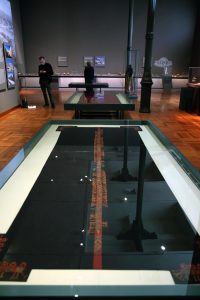Lima, Jun 22 (EFE).- Enigmatic and fascinating geometric images carved into the landscape are not the only remnants of one of ancient Peru’s most unique civilizations, whose wealth of ceramics, weavings and musical instruments make up the largest-ever exhibition dedicated to the Nasca culture.
The “NASCA” exhibition, on display until Oct. 1 at the Lima Art Museum, includes roughly 300 pieces – including three looms never exhibited before – that will later be presented at the Rietberg Museum in Zurich, Switzerland, and at the Bundeskunsthalle museum in Bonn, Germany, curators Cecilia Pardo and Peter Fux told EFE.

These vessels, jars, bottles and statuettes represent the same birds, whales and anthropomorphic beings depicted in the Nasca Lines, geoglyphs up to 370 meters (1,213 feet) long that depict animals and other figures and were carved some 2,000 years ago in one of the most arid regions on the planet.
Each of those colored objects tells a story – whether mundane or mythological – that helps investigators understand the cosmology and system of symbols behind the Nasca Lines.
These insights allowed them to intuit that those geoglyphs were far from untouchable and instead were used in processions and rituals in which hallucinogenic substances enabled a form of encounter with those mythological creatures.
“The exhibition is an opportunity to put the Nasca Lines in context and spread the idea that they were living spaces where they walked and danced in ceremonies,” Pardo said.
The exhibit also includes “antaras,” clay Andean panpipes, with which the Nasca developed a 13-note musical scale.
Those instruments must be “seen in context with the geoglyphs. Everything is rhythmical. When you walk in a spiral or zig-zag, it’s rhythm, like in music. The Nasca didn’t draw their lines so they would be visible (from the sky) but to feel them in processions and ceremonies,” Fux said.
